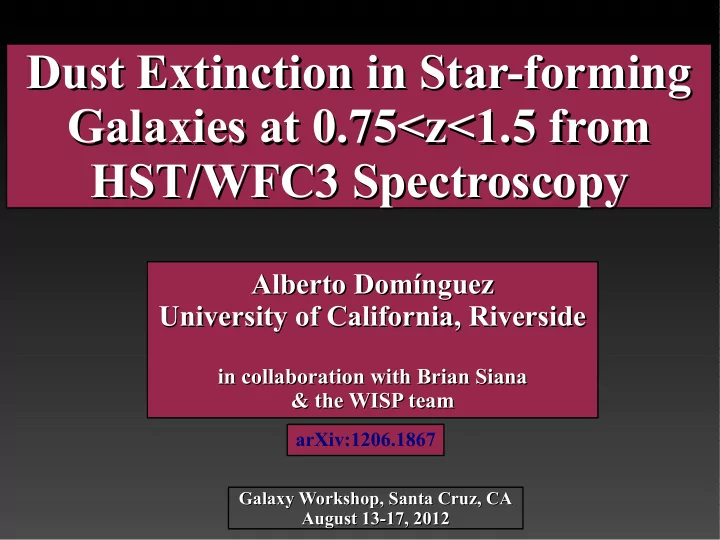

Dust Extinction in Star-forming Dust Extinction in Star-forming Galaxies at 0.75<z<1.5 from Galaxies at 0.75<z<1.5 from HST/WFC3 Spectroscopy HST/WFC3 Spectroscopy Alberto Domínguez Alberto Domínguez University of California, Riverside University of California, Riverside in collaboration with Brian Siana in collaboration with Brian Siana & the WISP team & the WISP team arXiv:1206.1867 Galaxy Workshop, Santa Cruz, CA Galaxy Workshop, Santa Cruz, CA August 13-17, 2012 August 13-17, 2012
What is and where is dust produced? Asymptotic-giant-branch stars ISM ISM ISM ISM Supernovae
Effects of the interstellar dust Dimming Reddening
Methodologies for studying dust extinction UV slopes and infrared observations that probes stellar-continuum extinction (e. g. Meurer et al. 1999; Reddy et al. 2010; Bouwens et al. 2011)
Methodologies for studying dust extinction Emission-line ratios such as Balmer emission lines that probes HII-regions extinction (e. g. Kennicutt et al. 1992; Hopkins et al. 2001; Brinchmann et al. 2004; Garn & Best 2010). Transition of n 3 → 2 4 → 2 5 → 2 6 → 2 Name Hα Hβ Hδ Hγ Wavelength (Ǻ) 6563 4861 4341 4102 Balmer series
Dust extinction at z>0.5 from emission-line ratios Ly et al. 2012 at z ~ 0.5 → combination of photometry and spectroscopy Sobral et al. 2012 at z ~ 1.5 → Hα/[O II] with [O II] being significantly dependent on metallicity.
The WFC3 Infrared Spectroscopic Parallel (WISP) survey Pure parallel Hubble Space Telescope program (PI Matthew Malkan) > 900 orbits, ~ 200 high-latitude fields. The faintest galaxies are 3 times fainter than galaxies previously studied at z ~ 1.5. G102: 0.80 ≤ λ ≤ 1.17 μm (R ~ 210) Atek et al. 2010 G141: 1.11 ≤ λ ≤ 1.67 μm (R ~ 130) Direct-imaging photometry: F475X, F600LP, F110W, F160W and IRAC 3.6 μm Example of different spectral features in one G141 grism image.
The WISP survey Atek et al. 2010
The WISP survey Atek et al. 2010
The WISP survey Atek et al. 2010
The WISP survey Atek et al. 2010
Galaxy stacks at 0.75 ≤ z ≤ 1.5 312 galaxies in 17 fields where both H α and H β fall simultaneously in the WISP spectral coverage → 129 galaxies after cleaning Rest-frame wavelength [Å]
Emission-line contamination - Hα and Hβ absorption (~ 25% in Hβ); BC03 models - [N II] (~ 15% in the worst case); Erb et al. 2006 - AGNs; BPT diagram
Emission-line contamination - Hα and Hβ absorption (~ 25% in Hβ); BC03 models - [N II] (~ 15% in the worst case); Erb et al. 2006 - AGNs; BPT diagram
Galaxy stacks at 0.75 ≤ z ≤ 1.5
Balmer decrements at z ~ 1
Dust extinction at z ~ 1 Assuming Calzetti et al. 2000 Assuming Calzetti et al. 2000 attenuation law attenuation law
Stellar vs. HII extinction Calzetti et al. 2000; E(B-V)stellar = (0.44+-0.03) E(B-V)
Conclusions 1.- The Hα/[O III] ratio is dependent on observed Hα luminosity. 2.- The Balmer decrement is correlated with observed Hα luminosity and galaxy stellar mass at z ~ 1. The faintest galaxies are consistent with no dust extinction. 3.- Clear evolution of dust extinction where for a given observed Hα luminosity, galaxies are significantly less extinguished at higher redshifts. No evolution is found with galaxy stellar mass. 4.- The typical procedure of assuming a constant extinction for all luminosity significantly overestimate extinction for the lower luminosity galaxies. 5.- WISP will improve the galaxy statistic more than a factor 10. 6.- WISP will publish results on the galaxy Hα luminosity and mass/metallicity relation very soon.
Backup
Backup
Backup
Recommend
More recommend